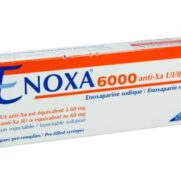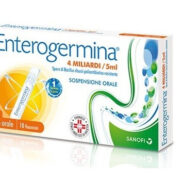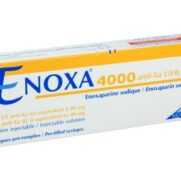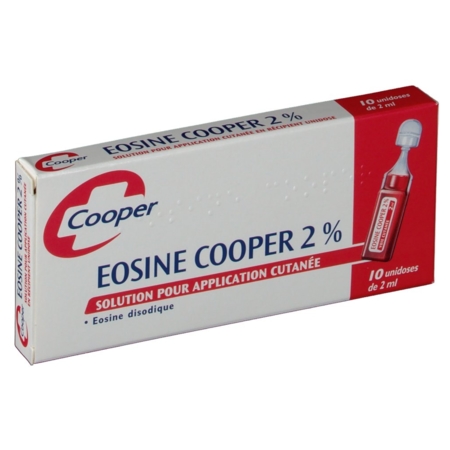1 ml contains 100 IU of insulin human.
1 vial contains 10 ml equivalent to 1,000 IU.
1 cartridge contains 3 ml equivalent to 300 IU.
1 pre-filled pen contains 3 ml equivalent to 300 IU.
One IU (International Unit) corresponds to 0.035 mg of anhydrous human insulin.
Mixtard is a mixture of dissolved insulin and isophane (NPH) insulin.
Mixtard 30 consists of 30% dissolved insulin and 70% isophane insulin.
Excipients/Inactive Ingredients: Zinc chloride, glycerol, metacresol, phenol, disodium phosphate dihydrate, sodium hydroxide/hydrochloric acid (for pH adjustment), protamine sulphate and water for injections.
Pharmacology: Pharmacodynamics: The blood glucose lowering effect of insulin is due to the facilitated uptake of glucose following binding of insulin to receptors on muscle and fat cells and to the simultaneous inhibition of glucose output from the liver.
Mixtard is a dual-acting insulin. Onset of action is within ½ hour, reaches a maximum effect within 2 – 8 hours and the entire duration of action is up to 24 hours.
Pharmacokinetics: Insulin in the blood stream has a half-life of a few minutes. Consequently, the time-action profile of an insulin preparation is determined solely by its absorption characteristics. This process is influenced by several factors (e.g. insulin dosage, injection route and site, thickness of subcutaneous fat, type of diabetes). The pharmacokinetics of insulin products are therefore affected by significant intra- and inter-individual variation.
Absorption: The absorption profile is due to the product being a mixture of insulin products with fast and protracted absorption respectively. The maximum plasma concentration of the fast-acting insulin is reached within 1.5 – 2.5 hours after subcutaneous administration.
Distribution: No profound binding to plasma proteins, except in circulating insulin antibodies (if present) has been observed.
Metabolism: Human insulin is reported to be degraded by insulin protease or insulin-degrading enzymes and possibly protein disulfide isomerase. A number of cleavage (hydrolysis) sites on the human insulin molecule have been proposed; none of the metabolites formed following the cleavage are active.
Elimination: The terminal half-life is determined by the rate of absorption from the subcutaneous tissue. The terminal half-life (t½) is therefore, a measure of the absorption rather than of the elimination per se of insulin from plasma (insulin in the bloodstream has a t½ of a few minutes). Trials have indicated a t½ of about 5-10 hrs.
Toxicology: Preclinical safety data: Non-clinical data reveal no special hazard for humans based on conventional studies of safety pharmacology, repeated dose toxicity, genotoxicity, carcinogenic potential, toxicity to reproduction.
Dosage is individual and determined in accordance with the needs of the patient. Blood glucose monitoring is recommended to achieve optimal glycaemic control. The individual insulin requirement is usually between 0.3 and 1.0 IU/kg/day. Adjustment of dose may be necessary if patients undertake increased physical activity, change their usual diet or during concomitant illness. The daily insulin requirement may be higher in patients with insulin resistance (e.g. during puberty or due to obesity) and lower in patients with residual, endogenous insulin production.
An injection should be followed within 30 minutes by a meal or snack containing carbohydrates.
Dosage adjustment: Concomitant illness, especially infections and feverish conditions, usually increases the patient’s insulin requirement. Concomitant diseases in the kidney, liver or affecting the adrenal, pituitary or thyroid gland can require changes in the insulin dose. Adjustment of dosage may also be necessary if patients change physical activity or their usual diet. Dosage adjustment may be necessary when transferring patients from one insulin preparation to another.
Administration: For subcutaneous use. Insulin suspensions are never to be administered intravenously.
Mixtard is administered subcutaneously in the thigh or abdominal wall. If convenient, the gluteal region or the deltoid region may also be used. Subcutaneous injection into the abdominal wall ensures a faster absorption than from other injection sites. Injection into a lifted skin fold minimises the risk of unintended intramuscular injection. The needle should be kept under the skin for at least 6 seconds to make sure the entire dose is injected. Injection sites should always be rotated within the same region in order to reduce the risk of lipodystrophy.
Mixtard is accompanied by a package leaflet with detailed instructions for use to be followed.
Mixtard vials are for use with insulin syringes with a corresponding unit scale.
Mixtard Penfill is designed to be used with Novo Nordisk delivery systems and NovoFine or NovoTwist needles.
Mixtard FlexPen is a pre-filled pen designed to be used with NovoFine or NovoTwist disposable needles up to a length of 8 mm. FlexPen delivers 1-60 units in increments of 1 unit.
Severe hypoglycaemic episodes, where the patient has become unconscious, can be treated with glucagon (0.5 to 1 mg) given intramuscularly or subcutaneously by a trained person, or with glucose given intravenously by a healthcare professional. Glucose must be given intravenously, if the patient does not respond to glucagon within 10 to 15 minutes.
Upon regaining consciousness, administration of an oral carbohydrate is recommended for the patient in order to prevent a relapse.
Hypoglycaemia may occur if the insulin dose is too high in relation to the insulin requirement. Omission of a meal or unplanned, strenuous physical exercise may lead to hypoglycaemia. Patients, whose blood glucose control is greatly improved e.g. by intensified insulin therapy, may experience a change in their usual warning symptoms of hypoglycaemia and should be advised accordingly. Usual warning symptoms may disappear in patients with longstanding diabetes.
Transferring a patient to another type or brand of insulin should be done under strict medical supervision. Changes in strength, brand (manufacturer), type, origin (human insulin, insulin analogue) and/or method of manufacture may result in a need for a change in dosage. Patients transferred to Mixtard from another type of insulin may require an increased number of daily injections or change in dosage from that used with their usual insulin products. If an adjustment is needed when switching the patient to Mixtard, it may occur with the first dose or during the first few weeks or months.
As with any insulin therapy, injection site reactions may occur and include pain, redness, hives, inflammation, bruising, swelling and itching. Continuous rotation of the injection site within a given area may help to reduce or prevent these reactions. Reactions usually resolve in a few days to a few weeks. On rare occasions, injection site reactions may require discontinuation of Mixtard.
Before travelling between different time zones, the patient should be advised to consult the physician, since this may mean that the patient has to take insulin and meals at different times.
Insulin suspensions are not to be used in insulin infusion pumps.
This product contains metacresol which can cause allergic reaction.
Combination of thiazolidinediones and insulin medicinal products: Cases of congestive heart failure have been reported when thiazolidinediones were used in combination with insulin, especially in patients with risk factors for development of congestive heart failure. This should be kept in mind if treatment with the combination of thiazolidinediones and insulin medicinal products is considered. If the combination is used, patients should be observed for signs and symptoms of congestive heart failure, weight gain and oedema. Thiazolidinediones should be discontinued if any deterioration in cardiac symptoms occurs.
Effects on ability to drive and use machines: The patient’s ability to concentrate and react may be impaired as a result of hypoglycaemia. This may constitute a risk in situations where these abilities are of special importance (e.g. driving a car or operating machinery).
Patients should be advised to take precautions to avoid hypoglycaemia while driving. This is particularly important in those who have reduced or absent awareness of the warning signs of hypoglycaemia or have frequent episodes of hypoglycaemia. The advisability of driving should be considered in these circumstances.
There is no restriction on treatment with Mixtard during breast-feeding.
Insulin treatment of the nursing mother presents no risk to the baby. However, the Mixtard dosage, diet or both may need to be adjusted.
At the beginning of the insulin treatment, refraction anomalies, oedema and injection site reactions (pain, redness, hives, inflammation, bruising, swelling and itching at the injection site) may occur. These reactions are usually of transitory nature. Fast improvement in blood glucose control may be associated with acute painful neuropathy, which is usually reversible. Intensification of insulin therapy with abrupt improvement in glycaemic control may be associated with temporary worsening of diabetic retinopathy, while long-term improved glycaemic control decreases the risk of progression of diabetic retinopathy.
Tabulated list of adverse reactions: Adverse reactions listed as follows are based on clinical trial data and classified according to MedDRA frequency and System Organ Class. Frequency categories are defined according to the following convention: Very common (≥ 1/10); common (≥ 1/100 to < 1/10); uncommon (≥ 1/1,000 to < 1/100); rare (≥ 1/10,000 to < 1/1,000); very rare (< 1/10,000); not known (cannot be estimated from the available data). (See table.)
 Click on icon to see table/diagram/image
Click on icon to see table/diagram/image
Description of selected adverse reactions: Anaphylactic reactions: The occurrence of generalised hypersensitivity reactions (including generalised skin rash, itching, sweating, gastrointestinal upset, angioneurotic oedema, difficulties in breathing, palpitation, reduction in blood pressure and fainting/loss of consciousness) is very rare but can potentially be life threatening.
Hypoglycaemia: The most frequently reported adverse reaction is hypoglycaemia. It may occur if the insulin dose is too high in relation to the insulin requirement. Severe hypoglycaemia may lead to unconsciousness and/or convulsions and may result in temporary or permanent impairment of brain function or even death. The symptoms of hypoglycaemia usually occur suddenly. They may include cold sweats, cool pale skin, fatigue, nervousness or tremor, anxiousness, unusual tiredness or weakness, confusion, difficulty in concentration, drowsiness, excessive hunger, vision changes, headache, nausea and palpitation.
Lipodystrophy: Lipodystrophy is reported as uncommon. Lipodystrophy may occur at the injection site.
The following substances may reduce the patient’s insulin requirement: Oral anti-diabetic products, monoamine oxidase inhibitors (MAOI), non-selective beta-blocking agents, angiotensin converting enzyme (ACE) inhibitors, salicylates, anabolic steroids and sulphonamides.
The following substances may increase the patient’s insulin requirement: Oral contraceptives, thiazides, glucocorticoids, thyroid hormones, sympathomimetics, growth hormone and danazol.
Beta-blocking agents may mask the symptoms of hypoglycaemia and delay recovery from hypoglycaemia.
Octreotide/lanreotide may either increase or decrease the insulin requirement.
Alcohol may intensify or reduce the hypoglycaemic effect of insulin.
After removing Mixtard from the refrigerator, it is recommended to allow it to reach room temperature before resuspending the insulin as instructed for first time use.
Insulin suspensions should not be used if they do not appear uniformly white and cloudy after resuspension.
Mixtard 30 HM Penfill/FlexPen: Cartridges/pens should only be used in combination with products that are compatible with them and allow the cartridge/pen to function safely and effectively.
Needles and Mixtard HM Penfill/FlexPen must not be shared. The container must not be refilled.
The patient should be advised to discard the needle after each injection.
Incompatibilities: Insulin suspensions should not be added to infusion fluids.
Keep the vial and cartridge in the outer carton and the pen cap on FlexPen in order to protect from light.
Mixtard must be protected from excessive heat and light.
After first opening or carried as a spare: Do not refrigerate.
Mixtard 30 HM vial: The in-use shelf life is 6 weeks when stored below 25°C or 5 weeks when stored below 30°C.
Mixtard 30 HM Penfill/FlexPen: The in-use shelf life is 6 weeks when stored below 30°C.
Shelf life: 30 months.
If you are allergic (hypersensitive) to human insulin or any of the other ingredients in Mixtard.
If you suspect hypoglycaemia (low blood sugar) is starting.
If the cartridge or the device containing the cartridge is dropped, damaged or crushed or if the protective cap is loose or missing. Each vial has a protective, tamper-proof plastic cap. If it is not in perfect condition when the patient gets the vial, return the vial to the pharmacy.
If it has not been stored correctly or been frozen.
If the resuspended insulin does not appear uniformly white and cloudy.
Before using Mixtard: Check the label to make sure it is the right type of insulin.
Mixtard 30 HM vial: Remove the protective cap.
Mixtard 30 HM Penfill: Always check the cartridge, including the rubber stopper. Do not use it if any damage is see nor if there is a gap between the rubber stopper and the white label band. Take it back to your pharmacy. See your delivery system manual for further instructions.
Always use a new needle for each injection to prevent contamination.
Needles and Mixtard HM Penfill must not be shared.
How to use this insulin: Mixtard is administered by injection under the skin (subcutaneously). Never inject insulin directly into a vein or muscle. Always vary the sites the patient injects within the same region, to reduce the risk of developing lumps or skin pitting. The best places to give an injection are: the front of waist (abdomen); buttocks; the front of thighs or upper arms. The insulin will work more quickly if the patient injects it around the waist.
How to inject Mixtard 30 HM vial: Make sure you have the correct syringe with the corresponding unit scale for insulin injections.
Draw air into the syringe in the same amount as the dose of insulin you need.
Follow the instructions given by your doctor or nurse.
Just before injecting this insulin, roll the vial between your hands until the liquid is uniformly white and cloudy. Resuspending is easier if the insulin has reached room temperature.
Inject the insulin under the skin. Use the injection technique advised by your doctor or nurse.
Keep the needle under your skin for at least 6 seconds to make sure that the full dose has been delivered.
Resuspending the Mixtard 30 HM Penfill insulin: Resuspending is easier when the insulin has reached room temperature.
Before you put the Penfill cartridge into the insulin delivery system, move it up and down and back so that the glass ball moves from one end of the cartridge to the other at least 20 times. Repeat this movement at least 10 times before each injection. The movement must always be repeated until the liquid appears uniformly white and cloudy. Complete the other stages of injection without delay.
Check there are at least 12 units of insulin left in the cartridge to allow even resuspending. If there are less than 12 units left, use a new one.
How to inject Mixtard 30 HM Penfill insulin: Inject the insulin under the skin. Use the injection technique advised by your doctor or nurse.
Keep the needle under your skin for at least 6 seconds. Keep the push-button fully depressed until the needle has been withdrawn. This will ensure correct delivery and limit possible flow of blood into the needle or insulin reservoir.
After each injection be sure to remove and discard the needle and store Mixtard without the needle attached. Otherwise the liquid may leak out which can cause inaccurate dosing.
Do not refill Mixtard HM Penfill.
Penfill cartridges are designed to be used with Novo Nordisk insulin delivery systems and NovoFine or NovoTwist needles. If you are treated with Mixtard HM Penfill and another insulin Penfill cartridge, you should use two insulin delivery systems, one for each type of insulin.
As a precautionary measure, always carry a spare insulin delivery system in case your Penfill is lost or damaged.
Instructions For Use For The Patient (FlexPen): Read the following instructions carefully before using your Mixtard FlexPen.
Your FlexPen is a unique dial-a-dose insulin pen. You can select doses from 1 to 60 units in increments of 1 unit. FlexPen is designed to be used with NovoFine or NovoTwist disposable needles up to a length of 8 mm. As a precautionary measure, always carry a spare insulin delivery device in case your FlexPen is lost or damaged.
Maintenance: Your FlexPen is designed to work accurately and safely. It must be handled with care. If it isdropped or crushed, there is a risk of damage and leakage of insulin.
You can clean the exterior of your FlexPen by wiping it with a medicinal swab. Do not soak it, wash or lubricate it as it may damage the pen.
Do not refill your Mixtard FlexPen.
Preparing your Mixtard FlexPen: Check the label to make sure that your Mixtard FlexPen contains the correct type of insulin. Before your first injection with a new FlexPen, you must resuspend the insulin: A. Let the insulin reach room temperature before you use it.
This makes it easier to resuspend.
Pull off the pen cap.
B. Move the pen up and down twenty times between the two positions, so the glass ball moves from one end of the cartridge to the other. Repeat until the liquid appears uniformly white and cloudy.
For every following injection move the pen up and down between the two positions at least 10 times until the liquid appears uniformly white and cloudy.
After you have resuspended the insulin, complete all the following steps of injection without delay.
Always check there are at least 12 units of insulin left in the cartridge to allow resuspension. If there are less than 12 units left, use a new FlexPen.
Attaching a needle: C. Remove the protective tab from a new disposable needle.
Screw the needle straight and tightly onto your FlexPen.
D. Pull off the big outer needle cap and keep it for later.
E. Pull off the inner needle cap and dispose of it.
Always use a new needle for each injection to prevent contamination.
Be careful not to bend or damage the needle before use.
To reduce the risk of unexpected needle sticks, never put the inner needle cap back on when you have removed it from the needle.
Checking the insulin flow: Prior to each injection, small amounts of air may collect in the cartridge during normal use.
To avoid injection of air and ensure proper dosing: F. Turn the dose selector to select 2 units.
G. Hold your FlexPen with the needle pointing upwards and tap the cartridge gently with your finger a few times to make any air bubbles collect at the top of the cartridge.
H. Keeping the needle upwards, press the push-button all the way in. The dose selector returns to 0.
A drop of insulin should appear at the needle tip. If not, change the needle and repeat the procedure no more than 6 times.
If a drop of insulin still does not appear, the pen is defective, and you must use a new one.
Selecting your dose: Check that the dose selector is set at 0.
I. Turn the dose selector to select the number of units you need to inject.
The dose can be corrected either up or down by turning the dose selector in either direction until the correct dose lines up with the pointer. When turning the dose selector, be careful not to push the push-button as insulin will come out.
You cannot select a dose larger than the number of units left in the cartridge.
Do not use the residual scale to measure your dose of insulin.
Making the injection: Insert the needle into your skin. Use the injection technique shown by your doctor or nurse.
J. Inject the dose by pressing the push-button all the way in until 0 lines up with the pointer. Be careful only to push the push-button when injecting.
Turning the dose selector will not inject insulin.
K. Keep the push-button fully depressed after the injection until the needle has been withdrawn from the skin.
The needle must remain under the skin for at least 6 seconds. This will ensure that the full dose has been injected.
L. Lead the needle into the big outer needle cap without touching the big outer needle cap. When the needle is covered, carefully push the big outer needle cap completely on and then unscrew the needle.
Dispose of it carefully and put the pen cap back on.
Always remove the needle after each injection and store your FlexPen without the needle attached. Otherwise the liquid may leak out which can cause inaccurate dosing.
Caregivers should be most careful when handling used needles to avoid needle sticks.
Dispose of the used FlexPen carefully without the needle attached.
Needles and Mixtard FlexPen must not be shared.









